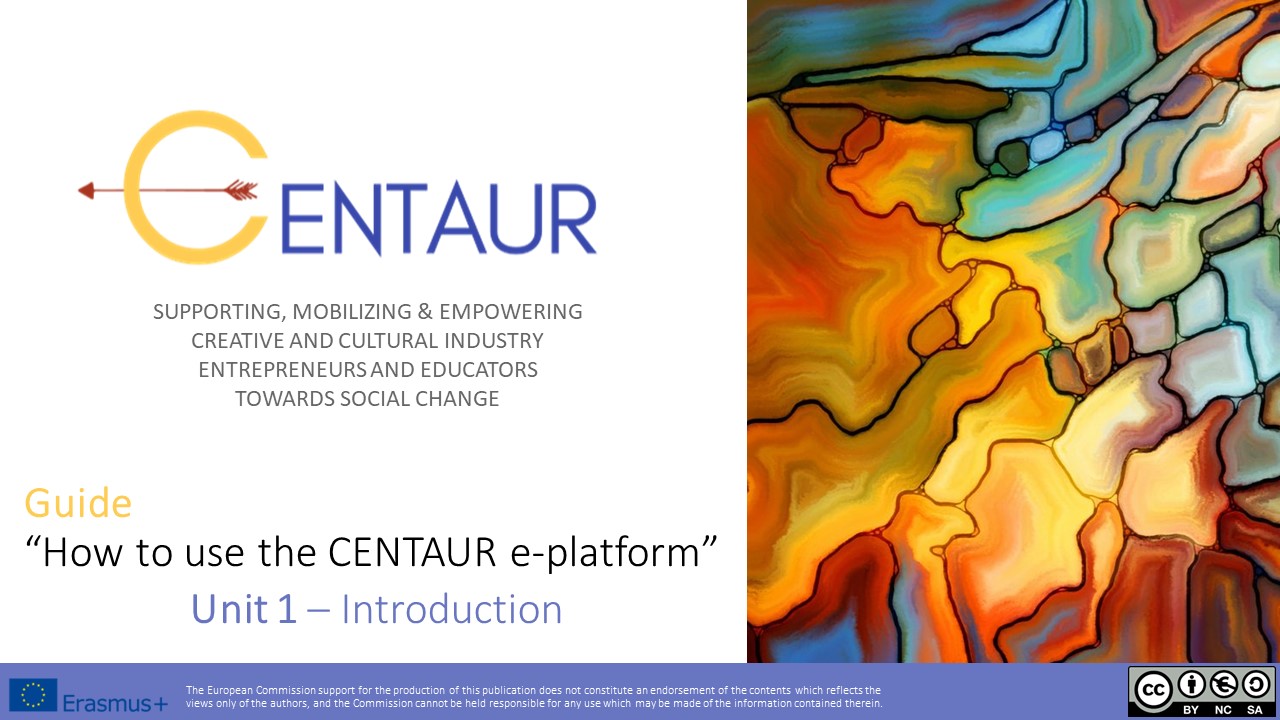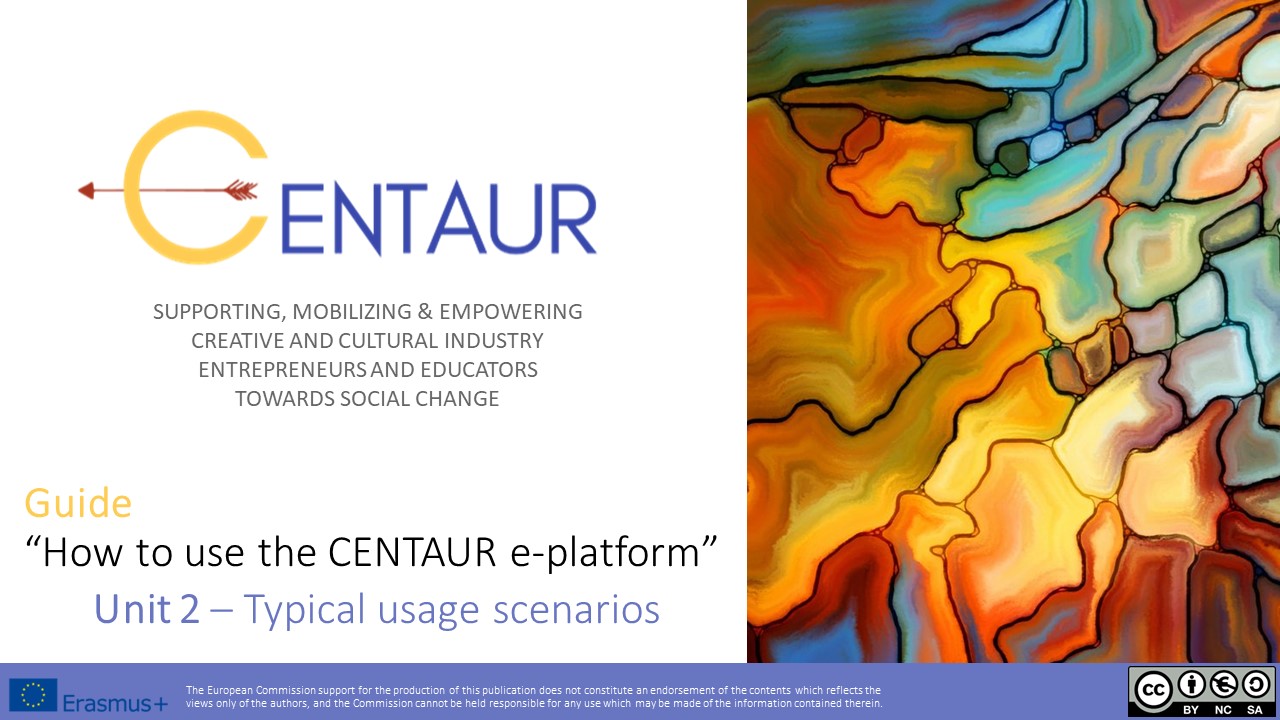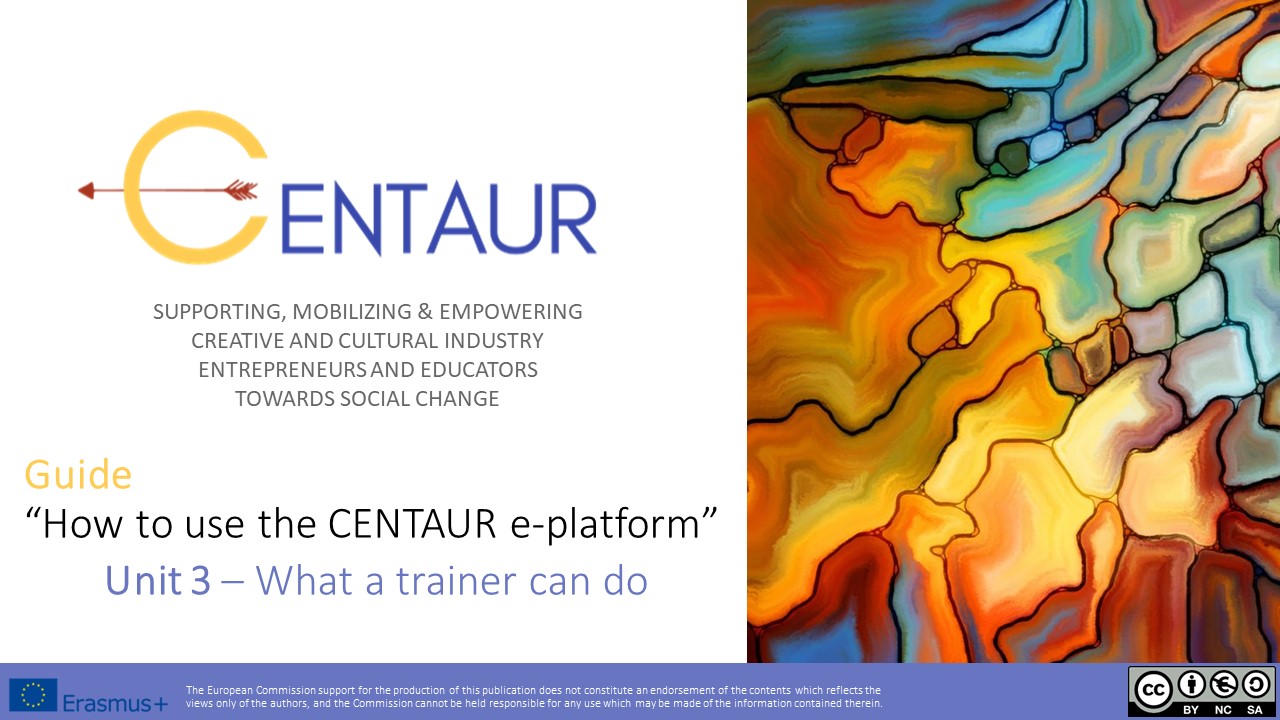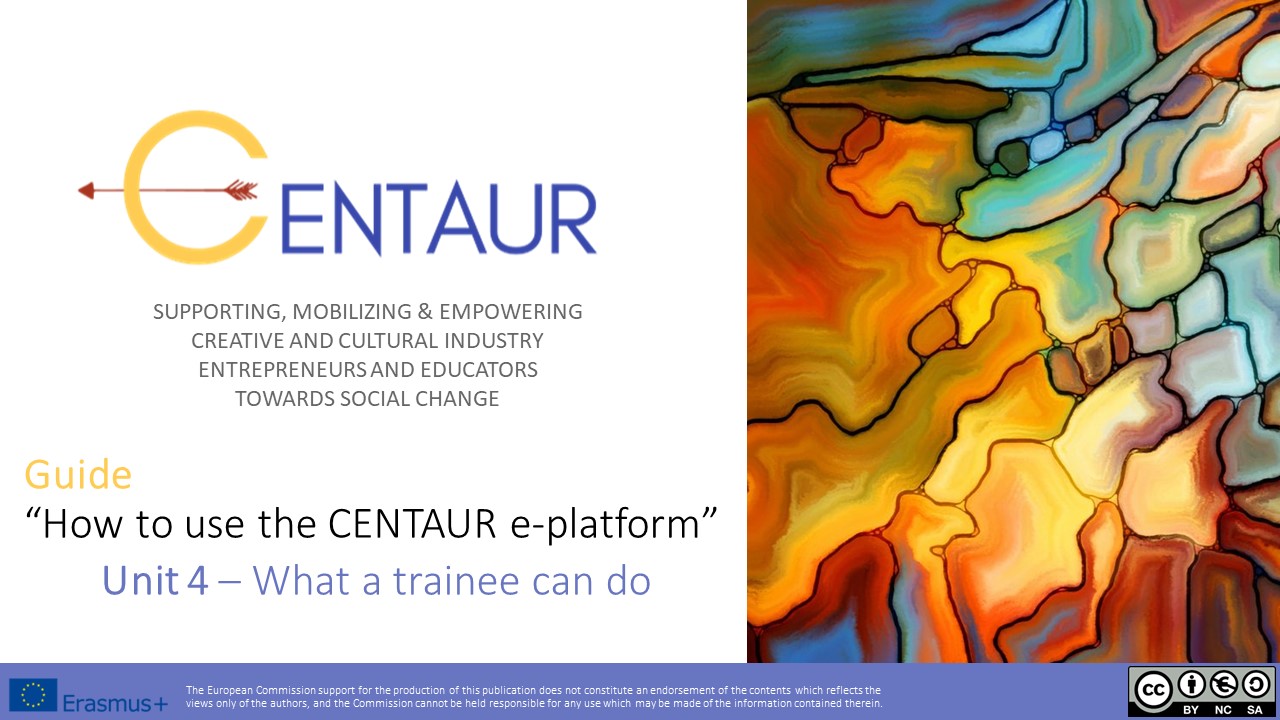Trainers Training Course (TTC-EN)

This is a course for Artists and Experts in adult education who want to be trained and become Centraur Trainers. It is an open, online, self-paced and gamified Trainers Training Course (without any face to face sessions).
Objectives
After reading this Guide you will:
- get familiarized with the CENTAUR platform
- be able to browse and view the available online material
- understand as a trainer/training organization what the material is about and how you can use it
View the Guide here.
You may download the "How to use th CENTAUR e-platform" guide from here [ PDF ], [ PPT ].
The European Commission support for the production of this publication does not constitute an endorsement of the contents which reflects the views only of the authors, and the Commission cannot be held responsible for any use which may be made of the information contained therein.
Less
This is a course for Artists and Experts in adult education who want to be trained and become Centraur Trainers. It is an open, online, self-paced and gamified Trainers Training Course (without any face to face sessions).
Objectives
After reading this Guide you will:
- get familiarized with the CENTAUR platform
- be able to browse and view the available online material
- understand as a trainer/training organization what the material is about and how you can use it
View the Guide here.
You may download the "How to use th CENTAUR e-platform" guide from here [ PDF ], [ PPT ].
The European Commission support for the production of this publication does not constitute an endorsement of the contents which reflects the views only of the authors, and the Commission cannot be held responsible for any use which may be made of the information contained therein.

This is a course for Artists and Experts in adult education who want to be trained and become Centraur Trainers. It is an open, online, self-paced and gamified Trainers Training Course (without any face to face sessions).
Objectives
After reading this Guide you will:
- get familiarized with the CENTAUR platform
- be able to browse and view the available online material
- understand as a trainer/training organization what the material is about and how you can use it
View the Guide here.
You may download the "How to use th CENTAUR e-platform" guide from here [ PDF ], [ PPT ].
The European Commission support for the production of this publication does not constitute an endorsement of the contents which reflects the views only of the authors, and the Commission cannot be held responsible for any use which may be made of the information contained therein.
Course Description

Further Reading
Mark Runco, Steven Pritzker: Encyclopedia of Creativity, Academic Press (1999)
Hardcover ISBN: 9780128156148, eBook ISBN: 9780128156155
Note: This is the most comprehensive handbook, and might be a standard for scientists from different disciplines, but too large and expensive for casual reading and with a strong focus on economy and management.
Mihalyi Csikszentmihalyi : Creativity: Flow and the Psychology of Discovery and Invention (1996),
(different editions in different languages)
A classic, but still interesting to read
References
- Tay L, Pawelski JO. The Oxford Handbook of the positive humanities. New York, NY: Oxford University Press; 2021. pages cm p.
- Lion A, Gunderman RB. How Intrapersonal Diversity Enhances Creativity: Leonardo da Vinci. Acad Radiol. 2019;26(7):999-1000.
- Dominiczak MH. Observation and creativity: Leonardo da Vinci. Clin Chem. 2012;58(5):960-1.
- Buckley PJ. Artemisia Gentileschi, 1593-1653. Am J Psychiatry. 2013;170(8):832-3.
- Mohacsy I. Artemisia Gentileschi and her world. J Am Acad Psychoanal Dyn Psychiatry. 2004;32(1):153-76; discussion 77-80.
- Artaud A, Corti V. The theater and its double. London: One World Classics; 2010. 150 p. p.
- Benjamin W, Lindner B, Nitsche J. Das Kunstwerk im Zeitalter seiner technischen Reproduzierbarkeit. Erste Auflage ed. Frankfurt: Suhrkamp; 2013. 722 pages p.
- Harmat Ls, Ørsted Andersen F, Sadlo G, Ullén F, Wright J. Flow Experience : Empirical Research and Applications. Cham: Springer International Publishing : Imprint: Springer, 2016.
- Lemon N. Creative expression and wellbeing in higher education : making and movement as mindful moments of self-care. Abingdon, Oxon ; New York, NY: Routledge,; 2023.
- Kreitler S. New Horizons in creativity. New York: Nova Science Publishers, Inc.; 2022. pages cm. p.
- Ferrando M, Ferrandiz C, Bermejo MR, Sanchez C, Parra J, Prieto MD. [Internal structure and standardised scores of the Torrance Test of Creative Thinking]. Psicothema. 2007;19(3):489-96.
- Warne RT, Golightly S, Black M. Factor structure of intelligence and divergent thinking subtests: A registered report. PLoS One. 2022;17(9):e0274921.
- Mouchiroud C, Lubart T. Children's original thinking: an empirical examination of alternative measures derived from divergent thinking tasks. J Genet Psychol. 2001;162(4):382-401.
- Gao Z, Zhang D, Liang A, Liang B, Wang Z, Cai Y, et al. Exploring the Associations Between Intrinsic Brain Connectivity and Creative Ability Using Functional Connectivity Strength and Connectome Analysis. Brain Connect. 2017;7(9):590-601.
- Gansler DA, Moore DW, Susmaras TM, Jerram MW, Sousa J, Heilman KM. Cortical morphology of visual creativity. Neuropsychologia. 2011;49(9):2527-32.
- Xurui T, Yaxu Y, Qiangqiang L, Yu M, Bin Z, Xueming B. Mechanisms of Creativity Differences Between Art and Non-art Majors: A Voxel-Based Morphometry Study. Front Psychol. 2018;9:2319.
- Sotiropoulos MG, Anagnostouli M. Genes, brain dynamics and art: the genetic underpinnings of creativity in dancing, musicality and visual arts. J Integr Neurosci. 2021;20(4):1095-104.
- Podlipniak P. The Role of Canalization and Plasticity in the Evolution of Musical Creativity. Front Neurosci. 2021;15:607887.
- Hassevoort KM, Lin AS, Khan NA, Hillman CH, Cohen NJ. Added sugar and dietary fiber consumption are associated with creativity in preadolescent children. Nutr Neurosci. 2020;23(10):791-802.
- Kapoula Z, Ruiz S, Spector L, Mocorovi M, Gaertner C, Quilici C, et al. Education Influences Creativity in Dyslexic and Non-Dyslexic Children and Teenagers. PLoS One. 2016;11(3):e0150421.
- Liu HY. Promoting creativity of nursing students in different teaching and learning settings: A quasi-experimental study. Nurse Educ Today. 2022;108:105216.
- de Souza LC, Volle E, Bertoux M, Czernecki V, Funkiewiez A, Allali G, et al. Poor creativity in frontotemporal dementia: a window into the neural bases of the creative mind. Neuropsychologia. 2010;48(13):3733-42.
- Rozenkrantz L, Mayo AE, Ilan T, Hart Y, Noy L, Alon U. Placebo can enhance creativity. PLoS One. 2017;12(9):e0182466.
- Have M, Nielsen JH, Gejl AK, Thomsen Ernst M, Fredens K, Stockel JT, et al. Rationale and design of a randomized controlled trial examining the effect of classroom-based physical activity on math achievement. BMC Public Health. 2016;16:304.
- Wei Z, Zhong C. Museums and art therapy: A bibliometric analysis of the potential of museum art therapy. Front Psychol. 2022;13:1041950.
- Luo Y, Lin R, Yan Y, Su J, Lin S, Ma M, et al. Effects of Remote Expressive Arts Program in Older Adults with Mild Cognitive Impairment: A Randomized Controlled Trial. J Alzheimers Dis. 2022.
- d'Errico I. Art as a Means of Accessing Ourselves. Using Art in Psychotherapy. Psychiatr Danub. 2017;29(Suppl 3):368-74.
- Bach F. The use of films in physical medicine and rehabilitation. Br J Phys Med. 1957;20(3):56-8.
- Beerse ME, Van Lith T, Stanwood G. Therapeutic psychological and biological responses to mindfulness-based art therapy. Stress Health. 2020;36(4):419-32.
- Schikler KN, Turner-Schikler LA. Expressive therapy in pediatric and adolescent gynecology. Obstet Gynecol Clin North Am. 1992;19(1):151-61.
- Hawkins N. A new outlook for rehabilitation: creative art therapy. Caring. 1993;12(11):80, 2, 4.
- Romero A, Garcia JE, Joshi GP. The state of the art in preventing post thoracotomy pain. Semin Thorac Cardiovasc Surg. 2013;25(2):116-24.
- Sittarame F, Estrada-Munoz M, Hausmann I, Thevoz X, Buhayer A, Mach F, et al. [A He(art) museum for an existential rebirth after a myocardial infarction]. Rev Med Suisse. 2022;18(783):1065-9.
- Ali K, Gammidge T, Waller D. Fight like a ferret: a novel approach of using art therapy to reduce anxiety in stroke patients undergoing hospital rehabilitation. Med Humanit. 2014;40(1):56-60.
- Deeb LC, Pettijohn FP, Shirah JK, Freeman G. Interventions among primary-care practitioners to improve care for preventable complications of diabetes. Diabetes Care. 1988;11(3):275-80.
Mark Runco, Steven Pritzker: Encyclopedia of Creativity, Academic Press (1999)
Hardcover ISBN: 9780128156148, eBook ISBN: 9780128156155
Note: This is the most comprehensive handbook, and might be a standard for scientists from different disciplines, but too large and expensive for casual reading and with a strong focus on economy and management.
Mihalyi Csikszentmihalyi : Creativity: Flow and the Psychology of Discovery and Invention (1996),
(different editions in different languages)
A classic, but still interesting to read
- Tay L, Pawelski JO. The Oxford Handbook of the positive humanities. New York, NY: Oxford University Press; 2021. pages cm p.
- Lion A, Gunderman RB. How Intrapersonal Diversity Enhances Creativity: Leonardo da Vinci. Acad Radiol. 2019;26(7):999-1000.
- Dominiczak MH. Observation and creativity: Leonardo da Vinci. Clin Chem. 2012;58(5):960-1.
- Buckley PJ. Artemisia Gentileschi, 1593-1653. Am J Psychiatry. 2013;170(8):832-3.
- Mohacsy I. Artemisia Gentileschi and her world. J Am Acad Psychoanal Dyn Psychiatry. 2004;32(1):153-76; discussion 77-80.
- Artaud A, Corti V. The theater and its double. London: One World Classics; 2010. 150 p. p.
- Benjamin W, Lindner B, Nitsche J. Das Kunstwerk im Zeitalter seiner technischen Reproduzierbarkeit. Erste Auflage ed. Frankfurt: Suhrkamp; 2013. 722 pages p.
- Harmat Ls, Ørsted Andersen F, Sadlo G, Ullén F, Wright J. Flow Experience : Empirical Research and Applications. Cham: Springer International Publishing : Imprint: Springer, 2016.
- Lemon N. Creative expression and wellbeing in higher education : making and movement as mindful moments of self-care. Abingdon, Oxon ; New York, NY: Routledge,; 2023.
- Kreitler S. New Horizons in creativity. New York: Nova Science Publishers, Inc.; 2022. pages cm. p.
- Ferrando M, Ferrandiz C, Bermejo MR, Sanchez C, Parra J, Prieto MD. [Internal structure and standardised scores of the Torrance Test of Creative Thinking]. Psicothema. 2007;19(3):489-96.
- Warne RT, Golightly S, Black M. Factor structure of intelligence and divergent thinking subtests: A registered report. PLoS One. 2022;17(9):e0274921.
- Mouchiroud C, Lubart T. Children's original thinking: an empirical examination of alternative measures derived from divergent thinking tasks. J Genet Psychol. 2001;162(4):382-401.
- Gao Z, Zhang D, Liang A, Liang B, Wang Z, Cai Y, et al. Exploring the Associations Between Intrinsic Brain Connectivity and Creative Ability Using Functional Connectivity Strength and Connectome Analysis. Brain Connect. 2017;7(9):590-601.
- Gansler DA, Moore DW, Susmaras TM, Jerram MW, Sousa J, Heilman KM. Cortical morphology of visual creativity. Neuropsychologia. 2011;49(9):2527-32.
- Xurui T, Yaxu Y, Qiangqiang L, Yu M, Bin Z, Xueming B. Mechanisms of Creativity Differences Between Art and Non-art Majors: A Voxel-Based Morphometry Study. Front Psychol. 2018;9:2319.
- Sotiropoulos MG, Anagnostouli M. Genes, brain dynamics and art: the genetic underpinnings of creativity in dancing, musicality and visual arts. J Integr Neurosci. 2021;20(4):1095-104.
- Podlipniak P. The Role of Canalization and Plasticity in the Evolution of Musical Creativity. Front Neurosci. 2021;15:607887.
- Hassevoort KM, Lin AS, Khan NA, Hillman CH, Cohen NJ. Added sugar and dietary fiber consumption are associated with creativity in preadolescent children. Nutr Neurosci. 2020;23(10):791-802.
- Kapoula Z, Ruiz S, Spector L, Mocorovi M, Gaertner C, Quilici C, et al. Education Influences Creativity in Dyslexic and Non-Dyslexic Children and Teenagers. PLoS One. 2016;11(3):e0150421.
- Liu HY. Promoting creativity of nursing students in different teaching and learning settings: A quasi-experimental study. Nurse Educ Today. 2022;108:105216.
- de Souza LC, Volle E, Bertoux M, Czernecki V, Funkiewiez A, Allali G, et al. Poor creativity in frontotemporal dementia: a window into the neural bases of the creative mind. Neuropsychologia. 2010;48(13):3733-42.
- Rozenkrantz L, Mayo AE, Ilan T, Hart Y, Noy L, Alon U. Placebo can enhance creativity. PLoS One. 2017;12(9):e0182466.
- Have M, Nielsen JH, Gejl AK, Thomsen Ernst M, Fredens K, Stockel JT, et al. Rationale and design of a randomized controlled trial examining the effect of classroom-based physical activity on math achievement. BMC Public Health. 2016;16:304.
- Wei Z, Zhong C. Museums and art therapy: A bibliometric analysis of the potential of museum art therapy. Front Psychol. 2022;13:1041950.
- Luo Y, Lin R, Yan Y, Su J, Lin S, Ma M, et al. Effects of Remote Expressive Arts Program in Older Adults with Mild Cognitive Impairment: A Randomized Controlled Trial. J Alzheimers Dis. 2022.
- d'Errico I. Art as a Means of Accessing Ourselves. Using Art in Psychotherapy. Psychiatr Danub. 2017;29(Suppl 3):368-74.
- Bach F. The use of films in physical medicine and rehabilitation. Br J Phys Med. 1957;20(3):56-8.
- Beerse ME, Van Lith T, Stanwood G. Therapeutic psychological and biological responses to mindfulness-based art therapy. Stress Health. 2020;36(4):419-32.
- Schikler KN, Turner-Schikler LA. Expressive therapy in pediatric and adolescent gynecology. Obstet Gynecol Clin North Am. 1992;19(1):151-61.
- Hawkins N. A new outlook for rehabilitation: creative art therapy. Caring. 1993;12(11):80, 2, 4.
- Romero A, Garcia JE, Joshi GP. The state of the art in preventing post thoracotomy pain. Semin Thorac Cardiovasc Surg. 2013;25(2):116-24.
- Sittarame F, Estrada-Munoz M, Hausmann I, Thevoz X, Buhayer A, Mach F, et al. [A He(art) museum for an existential rebirth after a myocardial infarction]. Rev Med Suisse. 2022;18(783):1065-9.
- Ali K, Gammidge T, Waller D. Fight like a ferret: a novel approach of using art therapy to reduce anxiety in stroke patients undergoing hospital rehabilitation. Med Humanit. 2014;40(1):56-60.
- Deeb LC, Pettijohn FP, Shirah JK, Freeman G. Interventions among primary-care practitioners to improve care for preventable complications of diabetes. Diabetes Care. 1988;11(3):275-80.
 In this unit the CENTAUR platform is introduced.
In this unit the CENTAUR platform is introduced.
- What is the CENTAUR e-platform?
- The structure of the Platform
- Choose your language
- No need for Registration or Login
- Sharing the link via Social Media Networks
I n this unit the main roles and usage scenarios are presented.
n this unit the main roles and usage scenarios are presented.
- Main roles: Trainer and Trainee
- What CENTAUR offers to a Trainer
- What CENTAUR offers to a Trainee
- Usage scenarios for Trainers
- scenario 1 - Preparation process for a Trainer
- scenario 2 - The Trainer organizes f2f training sessions
- scenario 3 - The Trainer makes use of the Adult Learners Space during a f2f training session
- Usage scenarios for a Trainee
- scenario 4 – Trainee’s preparation for participating in a f2f training session
- scenario 5 – A Trainee participates in a f2f training sessions
- scenario 6 – Any online Trainee uses self-study without guidance exercises
 In this Unit, the functionality available to a trainer is explained.
In this Unit, the functionality available to a trainer is explained.
- Creativity Handbook
- Training Course
- Networking Hub
- How to register
- How to use the Hub
- Be added, as a Trainer, to the CENTAUR Artist Data Base
- Exercises and how to search them
- How to use the dedicated Adult Learners Space
 In this Unit, the functionality available to a trainee is explained.
In this Unit, the functionality available to a trainee is explained.
- Artists/Trainer Data Base
- Self Assessment Tool (SAT)
- Questainnaire
- Results
- Self-study exercises via Mobile App
Calendar
Announcements
- - There are no announcements -
